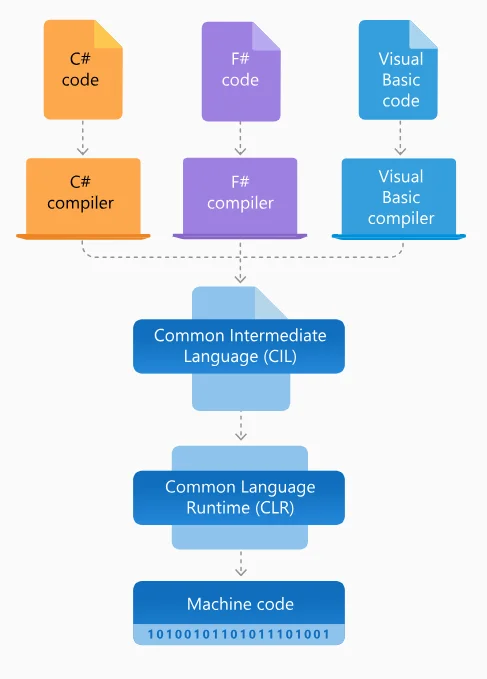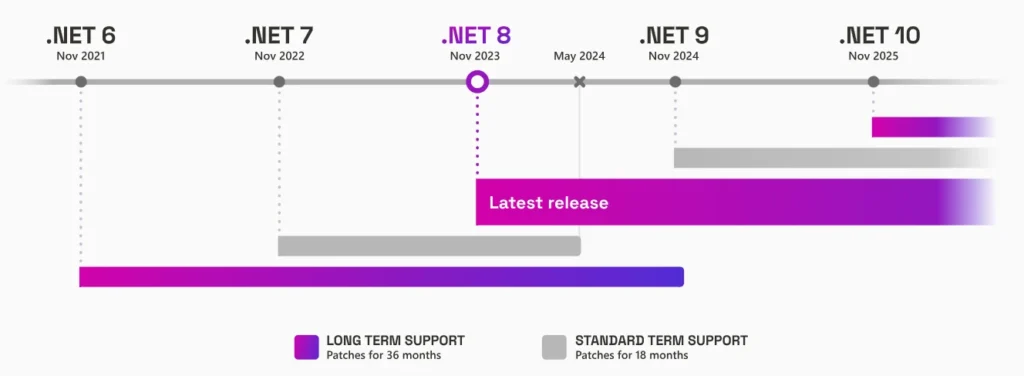An Overview of .NET and its Origins Along With .NET Terminologies
Author: Tim Connolley
.NET (dotnet) is a powerful and versatile platform for creating robust and scalable software solutions. In the ever-evolving field of software development, it has withstood the test of time. Microsoft developed .NET over 20 years ago, and since then, it has been a pivotal player in shaping the modern software development industry.
The purpose of this article is to give you an in-depth understanding of the evolution of .NET and its current role in modern software development. We will explore the significance of .NET and how it has empowered developers with a vast array of tools and libraries, enabling them to build efficient, feature-rich applications. We will delve into its origins, advancements, and its key role in shaping modern software development practices. By the end, you will have a deeper understanding of the impact and relevance of .NET in today’s industry.
If you’re new to .NET or an existing developer, you might find the distinctions between terms like .NET, .NET Framework, .NET Core, and .NET Standard; or ASP.NET, ASP.NET MVC, and ASP.NET CORE a bit confusing. Hang tight—we will try to clear up these misunderstandings as we progress.
Early Stages of .NET
In the late 90s Microsoft envisioned a platform that would allow developers to build several types of applications—web, desktop, mobile, and more—using a single, unified coding framework. At the time, Microsoft offered several different frameworks for different purposes that worked with different development languages. This created barriers to development across the different frameworks.
The main objectives of .NET were quite ambitious. Microsoft wanted to create a platform that would boost developer productivity, reduce the cost of software ownership, and enhance computing experiences for end-users. It aimed to provide tools and libraries that would allow developers to build interoperable, scalable, and robust applications with ease.
Over the years, .NET has evolved significantly. Initially, it was primarily used for Windows-based development. However, as the needs of modern developers have grown and changed, so has .NET. It has adapted to the demands of cross-platform development, cloud computing, and integration with other languages and platforms.
Key Components of .NET
.NET Framework achieved many of Microsoft’s goals in simplifying the code that developers had to write. It is made up of several components, each playing a crucial role in the functionality and productivity it offers developers.
Bridging the Gap:
- Common Language Runtime (CLR): The Common Language Runtime is a complete, high level virtual machine designed to support multiple programming languages that executes and manages .NET applications. It is the foundation that .NET apps are built on. It provides key features like memory management, type safety, exception handling, and more. Code written in .NET is sometimes called managed code. It is managed because the CLR provides those important services like garbage collection. In unmanaged code, developers had to manually handle those services.
- Language Interoperability: .NET supports multiple programming languages including C# (C-sharp), F# (F-sharp), and Visual Basic (VB.NET). Code written by developers in these high-level languages is compiled into an Intermediate Language (IL), also known as Common Intermediate Language (CIL) or Microsoft Intermediate Language (MSIL). The intermediate language is then compiled into machine code by the CLR for execution. Developers can focus on creating apps in their preferred language while using features written in other .NET languages. They do not need to rewrite source code.

Image Source: https://dotnet.microsoft.com/en-us/learn/dotnet/what-is-dotnet-framework
- .NET Class Libraries: An extended collection of reusable classes, interfaces, and value types that can be used by multiple applications. Developers can use class libraries to quickly implement useful functionality into their applications while focusing on business logic rather than common programming operations. There are three types of libraries:
- Platform-specific class libraries can only be used in a specific implementation of .NET. An example of this is the .NET Framework Class Library (FCL) for .NET Framework.
- Portable class Libraries (PCL) target multiple platforms by exposing common APIs from those platforms when built.
- .NET Standard class libraries are a merger between platform-specific and portable class libraries, providing the best of both. .NET Standard is the formal specification of the APIs common to the different .NET implementations. It is versioned and designed to be backwards compatible. Libraries built for a specific version of .NET Standard can run on any .NET implementation that targets that version of .NET Standard or higher.
.NET Implementations
There are several implementations of .NET. Each was developed at different times and meant to execute .NET code in different places such as Linux, macOS, Windows, iOS, Android, and more. Current supported .NET implementations include:
- .NET Framework: The original implementation of .NET for building applications and services on windows.
- .NET (Core): An open-source, cross-platform implementation for running websites, services and apps on Windows, Linux, and macOS.
- Xaramin/Mono: An implementation of .NET built to run apps on all major mobile operating systems.
- Universal Windows Platform (UWP): An implementation of .NET used to build modern, touch-enabled apps that run on Windows 10 and Windows 11 devices.
.NET Application Models
.NET App-model APIs are frameworks used to build specific types of applications within .NET or fulfill a specific workload need. The app-models vary based on implementation of .NET. These include:
- ASP.NET: A framework for building web apps and services. ASP.NET was released with .NET Framework. ASP.NET Core was released with .NET Core and later versions of .NET.
- .NET MAUI (Multi-Platform App UI): One framework to build cross-platform, native, cross-platform desktop, and mobile apps.
- Windows Desktop: A framework for building windows desktop applications. It includes Windows Presentation Foundation (WPF) and Windows Forms.
- ADO.NET and Entity Framework: APIs that support the development of data-oriented applications.
Evolution of .NET
Microsoft has consistently updated and improved .NET over the last two decades. Each new version brought enhancements in performance, stability, and security, as well as an expanded set of tools and libraries.
.NET Framework: Simplifying and Accelerating Development
In 2002, Microsoft released .NET Framework, the first implementation of .NET. It was a modern development platform for building websites, services, and desktop applications on windows. It was powerful, integrated easily with windows systems, security focused, and designed to be easily adopted by C++, Java, and Visual Basic (VB) programmers.
.NET Framework continues to be supported by Microsoft. It is currently on version 4.8.1.
NuGet: .NET Trending towards Open-Source
In 2009, Microsoft took two important steps into the open-source community. First, it released ASP.NET MVC as open source under the Microsoft Public License. Later that same year Microsoft created the non-profit corporation, the Outercurve Foundation, with the mission of “enabling the exchange of code and understanding among software companies and the open-source communities”.
A result of that non-profit was the release of NuGet in 2010. NuGet is a package manager that facilitates the sharing and use of packages that contain compiled code. By using NuGet packages, developers could easily import complex functionality into their projects.
.NET Core: Open-Source and Cross-Platform
.NET Framework is a Windows-only platform. The source code was eventually made available to the public but does not accept community contributions. In 2014 Microsoft announced that .NET Framework’s successor would be cross-platform and open-source. .NET Core was released in 2016 and could run on Windows, Linux, and MacOS. It was more modular and better suited to cloud applications. Due to this .NET Core became the choice for most new development, but it did not replace .NET Framework.
The introduction of .NET 5+
Microsoft released .NET 5 in 2020, merging .NET Core and .NET Framework. The name skipped version number 4 to avoid confusion with .NET Framework versions 4.x and it dropped the “core” to emphasize that it would be the main implementation of .NET going forward.
.NET 5+ supports more types of apps and more platforms than .NET Core or .NET Framework. While it is now the main implementation of .NET, it still has not replaced .NET Framework.
.NET 8
.NET 8 is the current .NET version, released in November 2023. It offers many improvements making it the fastest .NET to date, more capable of building cloud-native applications, container enhancements, improved AI integration, and more.
Role of .NET in Modern Software Development
In the modern software development landscape, .NET is a force to be reckoned with. Its support for cross-platform development allows developers to build applications that run on Windows, Linux, and macOS. This is a significant advantage in today’s diverse computing environment.
Additionally, cloud computing has transformed the way we develop and deploy software. With .NET, developers can easily build and deploy cloud-based applications. Microsoft Azure, for instance, offers a wide range of cloud services that can be easily integrated with .NET applications.
Moreover, .NET supports integration with popular programming languages, including Python and JavaScript. This makes it a versatile platform for developing complex applications. Not to mention, it provides outstanding support for web development, mobile apps, games, IoT, and more.
Benefits of Using .NET in Software Development
There are several advantages to using .NET in software development:
- Faster development process: .NET offers a large set of tools and libraries, which reduce the amount of code developers must write, resulting in a faster development process.
- Increased compatibility and scalability: .NET applications can run on multiple platforms, making the platform ideal for enterprises that require their software to be adaptable and scalable.
- Enhanced security features: .NET has robust security features that protect against various forms of cyber-attacks, thereby ensuring the secure transmission of data.
The Future of .NET
As technology evolves, so does .NET. It is also evident that Microsoft is investing heavily in integrating .NET with cutting-edge technologies like artificial intelligence (AI), machine learning (ML), and Internet of Things (IoT). These advancements are helping to position .NET as a future-ready platform.

Image Source: https://dotnet.microsoft.com/en-us/learn/dotnet/what-is-dotnet-framework
Finally, with continuous improvement and updates, .NET is set to remain a preferred choice for developers for a long time to come. Its robustness, versatility, and vast community support make it a reliable platform for future developments.
Conclusion
In conclusion, .NET has come a long way since its inception. It has evolved from a Windows-centric platform to a comprehensive, cross-platform, open-source framework that supports a variety of application types.
Its impact and relevance in the modern software development industry cannot be downplayed. Whether you are a developer looking to build a high-performance web application, a mobile app, or a cloud-based service, .NET has the tools and libraries to make your job easier.
The future of .NET looks promising. With continuous advancements and updates, .NET is set to meet the demands of modern software development head-on.




